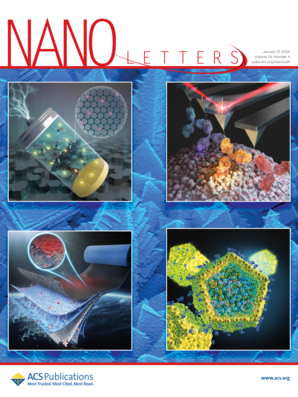用单边带技术揭示二硫化钼中铂取代掺杂剂的原子结构
IF 9.6
1区 材料科学
Q1 CHEMISTRY, MULTIDISCIPLINARY
引用次数: 0
摘要
我们将单个Pt原子替换为单层MoS2,并利用从头算模拟支持的单边带平面摄影(SSB)研究了所得的原子结构。我们证明,虽然高角度环形暗场(HAADF)扫描透射电子显微镜(STEM)成像提供了出色的z对比度,但由于相对对比度差低,区分某些缺陷类型(如单硫和双硫空位)仍然具有挑战性。然而,SSB具有接近线性的z -对比度和高相位灵敏度,可以在显着较低的电子剂量下可靠地识别这些缺陷构型以及各种Pt掺杂物结构。我们的发现揭示了精确的原子位置,并强调了SSB在对掺杂剂修饰的二维材料进行详细结构分析的潜力,同时最大限度地减少了光束引起的损伤,为理解和工程二维系统中的原子尺度特征提供了新的途径。本文章由计算机程序翻译,如有差异,请以英文原文为准。

Uncovering the Atomic Structure of Substitutional Platinum Dopants in MoS2 with Single-Sideband Ptychography
We substitute individual Pt atoms into monolayer MoS2 and study the resulting atomic structures with single-sideband ptychography (SSB) supported by ab initio simulations. We demonstrate that while high-angle annular dark-field (HAADF) scanning transmission electron microscopy (STEM) imaging provides excellent Z-contrast, distinguishing some defect types such as single and double sulfur vacancies remains challenging due to their low relative contrast difference. However, SSB with its nearly linear Z-contrast and high phase sensitivity enables reliable identification of these defect configurations, as well as various Pt dopant structures at significantly lower electron doses. Our findings uncover the precise atomic placement and highlight the potential of SSB for detailed structural analysis of dopant-modified 2D materials while minimizing beam-induced damage, offering new pathways for understanding and engineering atomic-scale features in 2D systems.
求助全文
通过发布文献求助,成功后即可免费获取论文全文。
去求助
来源期刊

Nano Letters
工程技术-材料科学:综合
CiteScore
16.80
自引率
2.80%
发文量
1182
审稿时长
1.4 months
期刊介绍:
Nano Letters serves as a dynamic platform for promptly disseminating original results in fundamental, applied, and emerging research across all facets of nanoscience and nanotechnology. A pivotal criterion for inclusion within Nano Letters is the convergence of at least two different areas or disciplines, ensuring a rich interdisciplinary scope. The journal is dedicated to fostering exploration in diverse areas, including:
- Experimental and theoretical findings on physical, chemical, and biological phenomena at the nanoscale
- Synthesis, characterization, and processing of organic, inorganic, polymer, and hybrid nanomaterials through physical, chemical, and biological methodologies
- Modeling and simulation of synthetic, assembly, and interaction processes
- Realization of integrated nanostructures and nano-engineered devices exhibiting advanced performance
- Applications of nanoscale materials in living and environmental systems
Nano Letters is committed to advancing and showcasing groundbreaking research that intersects various domains, fostering innovation and collaboration in the ever-evolving field of nanoscience and nanotechnology.
 求助内容:
求助内容: 应助结果提醒方式:
应助结果提醒方式:


